Abstract
content
- Introduction
- 1. Theme urgency
- 2. Goal and tasks of the research
- 3. Device hardware development
- Conclusion
- References
Introduction
In recent decades, the development of microelectronics and computer science has led to the rapid growth of telecommunications technologies. As of 2018, according to the data of the analytical agency "We Are Social", the number of users of the global Internet has reached 4,021 billion. a person and continues to grow. With the spread of smartphones, tablet computers and other mobile devices, wireless Internet access technologies have been widely developed through mobile communication networks or local Wi-Fi networks. As a result of this, as well as the emergence of cloud computing, the development of software-based networks and the development of machine-to-machine interaction technologies, the concept of the Internet of Things has been practically developed.
1. Theme urgency
The concept of the Internet of Things (English Internet of Things, IoT) is the concept of a computer network of physical objects ("things") equipped with built—in technologies for interacting with each other or with the external environment, considering the organization of such networks as a phenomenon capable of reconstructing economic and social processes, eliminating the need for human participation from part of actions and operations.
That is, to put it simply, the Internet of Things is a kind of network connecting the things around us. Things mean anything, any device or car, from a passenger car to a "smart" house with all its contents.
Lighting, garden watering, heating, air conditioning, control over electricity consumption, security and fire alarm systems have all been automated for a long time, but now all the "things" controlling these processes can be combined into a single computer network. In total, in the very near future, we may see refrigerators controlling the number of products and "re-ordering" them as needed in the online store, pre-interviewing other kitchen appliances about their needs for products, medicines with an identification label reminding us that it's time to take them, etc. Everything that is still found only in the stories of science fiction writers may become in the near future, but somewhere it is already becoming a reality.
In this thesis, all the advantages and disadvantages will be considered, as well as the simplest, but nevertheless important device related to the Internet of Things — Wi-Fi relay for underfloor heating control will be investigated and assembled.
2. Goal and tasks of the research
Development of an approach to the unification of synthesis Moore FSM, directing on hardware amount reduction in FPGA is the goal of research.
The aim of the work is to develop a relay with wireless control, based on the ESP 8266 microcontroller, in particular the ESP-01 module, for remote control of underfloor heating using wireless Wi-Fi technology and the worldwide Internet.
Main tasks of the research:
- Selection of equipment.
- Modeling of a circuit diagram in the Proteus environment.
- Development of a 3-D housing model.
- Development of a underfloor heating control algorithm.
- Writing a program for a microcontroller.
3. Device hardware development
In 2014, at that time unknown to anyone, the Chinese manufacturer Espressif Systems launched the ESP 8266 microcontroller with Wi-Fi interface (Fig. 1). A feature of the microcontroller, in addition to Wi-Fi, is the absence of flash memory in the SoC, so user programs are executed from an external flash memory that supports the SPI interface. But the main advantage of this microcontroller, which allowed it to become very popular and become widespread, was its price. It, at the time of its appearance on the market, turned out to be unusually low.
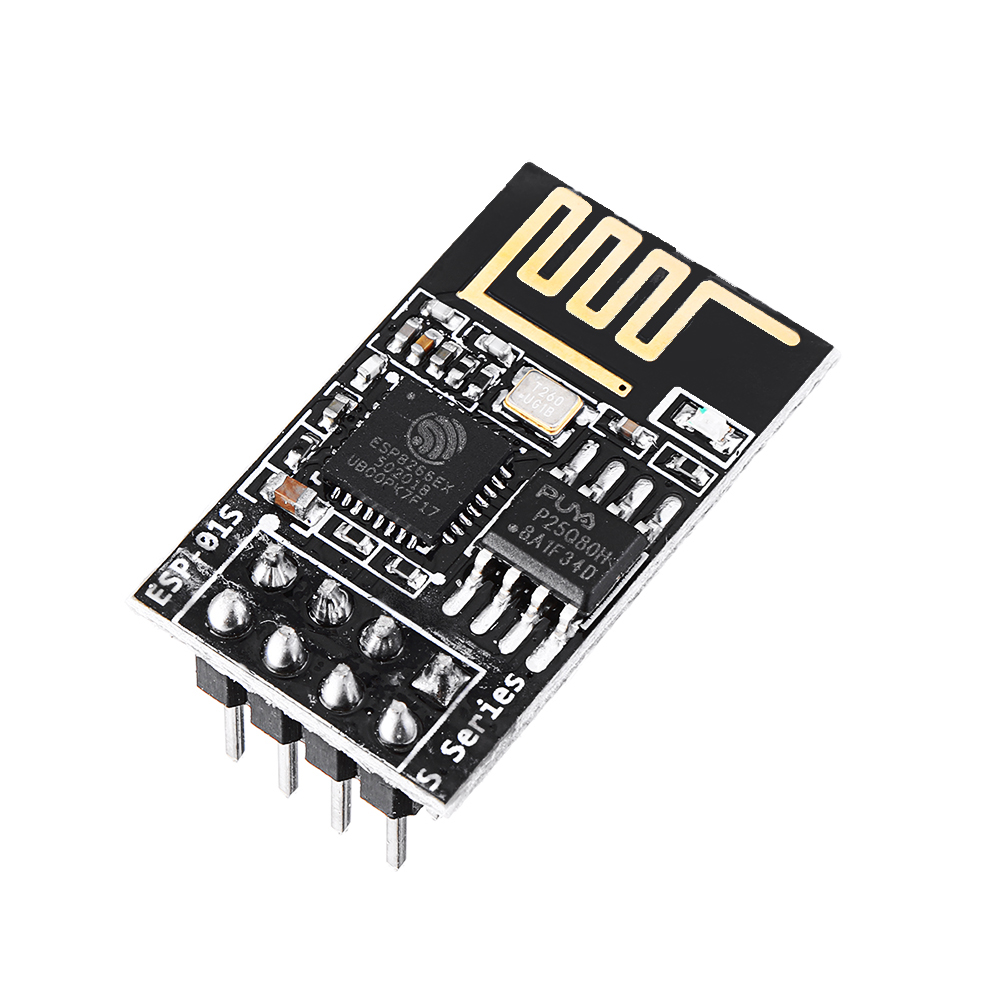
Figure 1 – the ESP-01 board
In this project, the ESP-01 module will be used, since its capabilities are quite sufficient for the tasks set, and at the same time it is very compact and inexpensive.
The ESP-01 module is a small board, black or dark green in color, on which two main chips are located, this is an ESP8266 microcontroller and a 1 MB flash memory. Nearby there is a quartzite resonator and a printed antenna. Two LEDs, red and blue, are installed on the board. The red LED lights up when there is power on the module, and the blue one flashes when executing commands (the red LED has been removed in ESP-01S, due to constant power consumption). To connect the ESP-01 module, eight pins are provided (two rows of four pins, in 2.54 mm increments), two of which are digital inputs-outputs that support pulse width modulation.
To implement the main function of a wireless relay - switching, we need to pick up additional equipment, in particular relays. Since there are limitations in dimensions within the framework of this project, two options were considered: small-sized electromechanical relays and solid-state relays.
Considering the fact that the voltage on the legs of the microcontroller is 3.3 V and a relay with a supply voltage of 3 V is very difficult to find on sale. Then the preferred option would be a solid-state relay, which is an optosymistor (a triac controlled by an optocoupler), for example OMRON G3MB-202P (see Figure 2). Although according to the passport, the control voltage on this relay is 5 V, it has been experimentally established that the relay operates stably even at a voltage of 2.5 V. Unfortunately, the model range of these relays is limited by the load current of 3 A, and this, in the presence of a large number of powerful household consumers (air conditioners, slow cookers, electric kettles, etc.), is no longer enough.
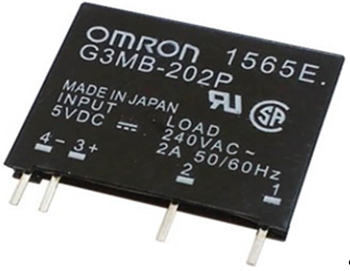
Figure 2 – Appearance of the OMRON solid-state relay
The next candidate was the mechanical relay Songle SRD-5VDC-SL-C (Fig. 3), since it allows switching loads up to 10A, has two pairs of power contacts, one is normally closed (NC), the second is normally open (NO). The disadvantages of this type of relay include mechanical wear of contacts, which limits the number and frequency of switching.
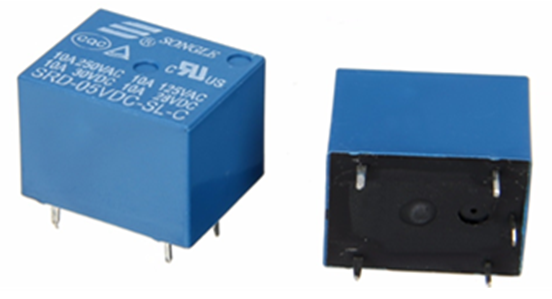
Figure 3 – electromechanical relay Songle SRD-5VDC-SL-C
Another common variant of a solid-state relay is the SSR-25DA module (Fig. 4), which has good operational characteristics, such as a good control voltage range (3-32V), a high operating load current (up to 25A, but there are models for a larger current), a convenient housing for mounting to the radiator and a low price (about $4-5).
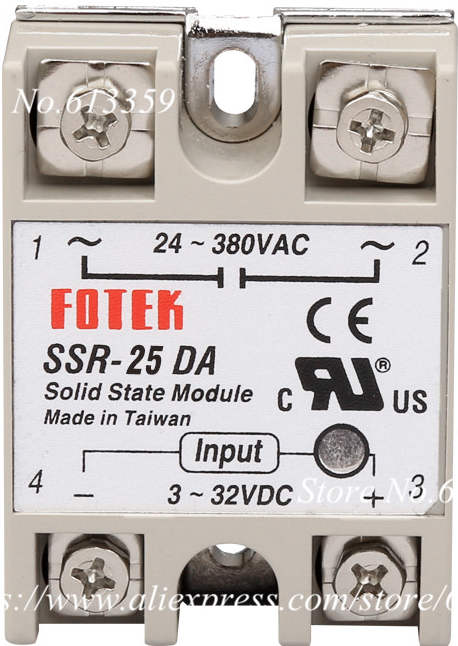
Figure 4 – SSR-25DA Solid State relay
However, it was decided to abandon the use of this module in this project due to the large overall parameters, and it was decided to make its own version of a solid-state relay based on a triac optocoupler and a power triac. Solid-state relays have advantages such as high mechanical reliability due to the absence of mechanical contacts and a much higher on/off life, as well as a high switching frequency. However, such a device is not without drawbacks, due to the use of semiconductor components, such a device is subject to heating, which increases with increasing load.
The BTA140 was chosen as a power triac in the TO220 housing, which has such characteristics as: operating voltage up to 800V and operating current up to 25A, which in theory will allow switching power up to 20kW (when using specialized cooling).
Development of a schematic diagram of electrical connections
The circuit will include several main nodes, namely: a microcontroller and optocoupler power supply node, a microcontroller node with the necessary binding and a transistor, and a power node consisting of a power triac and a snubber circuit.
The power supply unit of the low-voltage part is shown in Figure 5, it includes a voltage converter, a varistor, a fuse and an output capacitor.

Figure 5 – Schematic electrical diagram of the device power supply
The varistor in this scheme performs a protective function. It protects the converter from high voltage surges. When the voltage rises above a certain voltage, the resistance of the varistor decreases sharply and shorts the power supply circuit and disables the fuse, protecting the rest of the circuit from increased mains voltage by this action.
The low-voltage node is shown in Figure 6
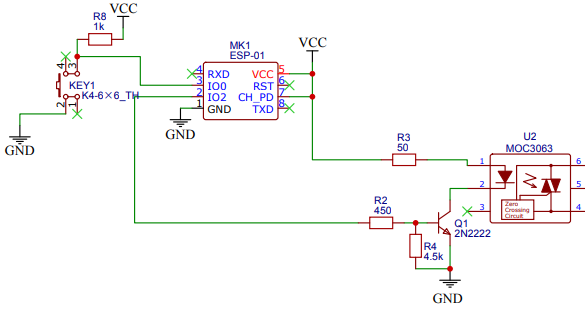
Figure 6 – low-voltage node
This node is represented by the ESP-01 Wi-fi module, which is the main control element of the device, the moc3063 semistor optocoupler necessary to control the power triac and galvanic isolation of the control circuit from the power voltage, the 2n2222 bipolar transistor necessary to ensure the necessary current flows through the optocoupler LED, which the microcontroller cannot do directly due to its own limitations. The circuit also provides for tightening the necessary terminals to the ground or power supply for correct operation, as well as a clock button necessary to switch the device to programming mode or local control of the switching process.
The power part of the circuit is shown in Figure 7
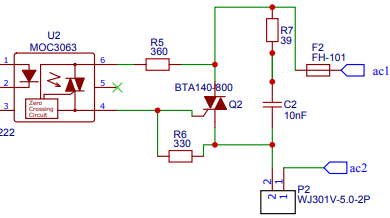
Figure 7 – The power part of the circuit
The power part of the circuit consists of an optocoupler with a triac output, a power triac, a fuse, a snubber circuit and power screw terminal blocks.
The optocoupler receiving the control signal opens the optosimistor at the moment of zero voltage on it (zero crossing), which in turn opens the power triac switching the payload.
The snubber circuit is necessary for the device to operate on an active-inductive load, compensating for the reactive power of the inductive component of the load.
Conclusion
During the implementation of this project, a schematic diagram was developed with a solid-state relay for controlling underfloor heating based on the ESP 8266 microcontroller, for remote control using wireless Wi-Fi technology.
At the time of writing this abstract, the master's work has not yet been completed. Approximate date of completion of the master's thesis: June 2023. The full text of the work and materials on the topic can be obtained from the author or his supervisor after the specified date.
References
- Gilbert Ndayisenga, Omar Gatera, Charles Kabiri, Janvier Niyitegeka, Delphine Bampire, Sophonie Harerimana, "IoT Based Household Water Consumption Management System", 2022 IEEE PES/IAS PowerAfrica, pp.1-4, 2022.
- Manoj Saini, Shagufta Khan, Vipul Dutt Mishra, Manav Mehra, Deeksha Singh, Gopal Sengar, "IoT Based Hybrid EV Charging System with Data Processing", 2022 International Conference on Intelligent Controller and Computing for Smart Power (ICICCSP), pp.1-5, 2022.
- A. V. Zinkevich, "ESP8266 Microcontroller Application in Wireless Synchronization Tasks," 2021 International Conference on Industrial Engineering, Applications and Manufacturing (ICIEAM), 2021, pp. 670-674.
- P. Macheso, T. D. Manda, S. Chisale, N. Dzupire, J. Mlatho and D. Mukanyiligira, "Design of ESP8266 Smart Home Using MQTT and Node-RED," 2021 International Conference on Artificial Intelligence and Smart Systems (ICAIS), 2021, pp. 502-505.
- Jevgenijs Telicko, Andris Jakovics, "Power efficient wireless monitoring system based on ESP8266", 2022 IEEE 63th International Scientific Conference on Power and Electrical Engineering of Riga Technical University (RTUCON), pp.1-6, 2022.
- Falia Innocentia Ananda Sunarko, Epyk Sunarno, Diah Septi Yanarati, Eny Kusumawati, "Smart DC Home for Energy Saving with Android-Based Real-Time Energy Monitoring", 2022 International Electronics Symposium (IES), pp.156-161, 2022.
- S. S. Pakalapati, G. G. Chary, A. K. Yadaw, S. Kumar, H. K. Phulawariya and R. Kumar, "A prosthetic hand control interface using ESP8266 Wi-Fi module and Android application," 2017 International Conference on Innovations in Information, Embedded and Communication Systems (ICIIECS), 2017, pp. 1-3
- Ivan Vaccari, Maurizio Aiello, Federico Pastorino, Enrico Cambiaso, "Protecting the ESP8266 Module from Replay Attacks", 2020 International Conference on Communications, Computing, Cybersecurity, and Informatics (CCCI), pp.1-6, 2020.
- Ziyu Wan, Yunkai Song, Zhuli Cao, "Environment Dynamic Monitoring and Remote Control of Greenhouse with ESP8266 NodeMCU", 2019 IEEE 3rd Information Technology, Networking, Electronic and Automation Control Conference (ITNEC), pp.377-382, 2019.
- Thongchai Pornchaiyasutthi, Tanapat Anusas-amornkul, "A Model for Victim-Rescuer Communications under Collapsed Structures using Node MCU ESP8266", Proceedings of the 2019 2nd International Conference on Electronics, Communications and Control Engineering - ICECC 2019, pp.34, 2019.
- P. S. B. Macheso, T. D. Manda, A. G. Meela, J. S. Mlatho, G. T. Taulo and B. M'mame, "Environmental Parameter Monitoring System Based on NodeMCU ESP8266, MQTT and Node-RED," 2022 International Conference on Computer Communication and Informatics (ICCCI), 2022, pp. 1-4.
- P. Srivastava, M. Bajaj and A. S. Rana, "IOT based controlling of hybrid energy system using ESP8266," 2018 IEEMA Engineer Infinite Conference (eTechNxT), 2018, pp. 1-5
- Farah Khaliq Baloch, Ghulam E Mustafa Abro, Waheed Ali Laghari, Zubair Adil Soomro, Asif.A. Rahimoon, Rahul Kumar, "Controlling and Monitoring of Hybrid Power System Using an Android Application", 2022 IEEE 5th International Symposium in Robotics and Manufacturing Automation (ROMA), pp.1-5, 2022.
- M. D. Bhujbal, M. G. Unde, "Real Time Monitoring and Security of Solar Power Plant Using IoT", 2022 IEEE India Council International Subsections Conference (INDISCON), pp.1-5, 2022.
- Ashim Mondal, Md Jishan Ali, Pallav Dutta, "IoT Enabled Smart Solar Panel Monitoring System Based on Boltuino Platform", 2022 IEEE International IOT, Electronics and Mechatronics Conference (IEMTRONICS), pp.1-7, 2022.
- Ivan Vaccari, Maurizio Aiello, Federico Pastorino, Enrico Cambiaso, "Protecting the ESP8266 Module from Replay Attacks", 2020 International Conference on Communications, Computing, Cybersecurity, and Informatics (CCCI), pp.1-6, 2020.
- Fatih Ertam, Ilhan Firat Kilincer, Orhan Yaman, Abdulkadir Sengur, "A New IoT Application for Dynamic WiFi based Wireless Sensor Network", 2020 International Conference on Electrical Engineering (ICEE), pp.1-4, 2020.
- Jihen Souifi, Yassine Bouslimani, Mohsen Ghribi, Azeddine Kaddouri, Tobie Boutot, Hsan Hadj Abdallah, "Smart Home Architecture based on LoRa Wireless Connectivity and LoRaWAN® Networking Protocol", 2020 1st International Conference on Communications, Control Systems and Signal Processing (CCSSP), pp.95-99, 2020.
